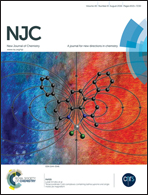Catecholase activity of Mannich-based dinuclear CuII complexes with theoretical modeling: new insight into the solvent role in the catalytic cycle†
Abstract
Four new dinuclear CuII complexes were synthesised from two Mannich-base ligands namely 2,6-bis[bis(2-methoxyethyl)aminomethyl]-4-chlorophenol (HL1) and 2-[bis(2-methoxyethyl)aminomethyl]-4-chlorophenol (HL2): [Cu2(L1)(OH)](ClO4)2·CH3OH (1), [Cu2(L2)2](ClO4)2·H2O (2), [Cu2(L2)2(NO3)2] (3) and [Cu2(L2)2(OAc)2]·H2O (4) and well characterised. X-ray diffraction analysis of the complexes reveals a Cu⋯Cu distance of 2.9183(13), 2.9604(6), 3.0278(4) and 3.0569(11) Å, respectively. In 1 the metal coordination geometry is intermediate between trigonal bipyramidal (TBP) and square pyramidal (SP) (τ = 0.488), in 2 the geometry is TBP (0.828 and 0.639) and in 3 and 4 is SP (τ = 0.188 and 0.083, respectively). Spectrophotometric investigations to evaluate the catecholase activity of complexes against 3,5-di-tert-butylcatechol (3,5-DTBC) and tetrachlorocatechol (TCC) in three different solvents (acetonitrile, methanol and DMSO) under completely aerobic conditions reveal that complexes 1–4 are able to oxidise 3,5-DTBC in all the solvents, while TCC can be oxidised only in acetonitrile (kcat = 0.0002–0.02 s−1). Intensive DFT calculations prove an ionic pathway for 1–3 while a unique neutral catalytic cycle for 4.


 Please wait while we load your content...
Please wait while we load your content...